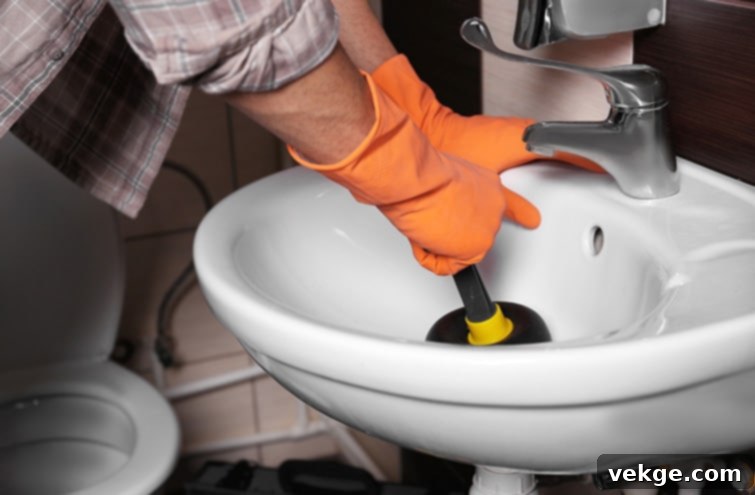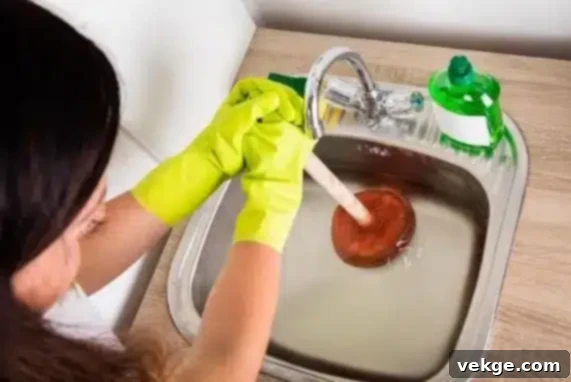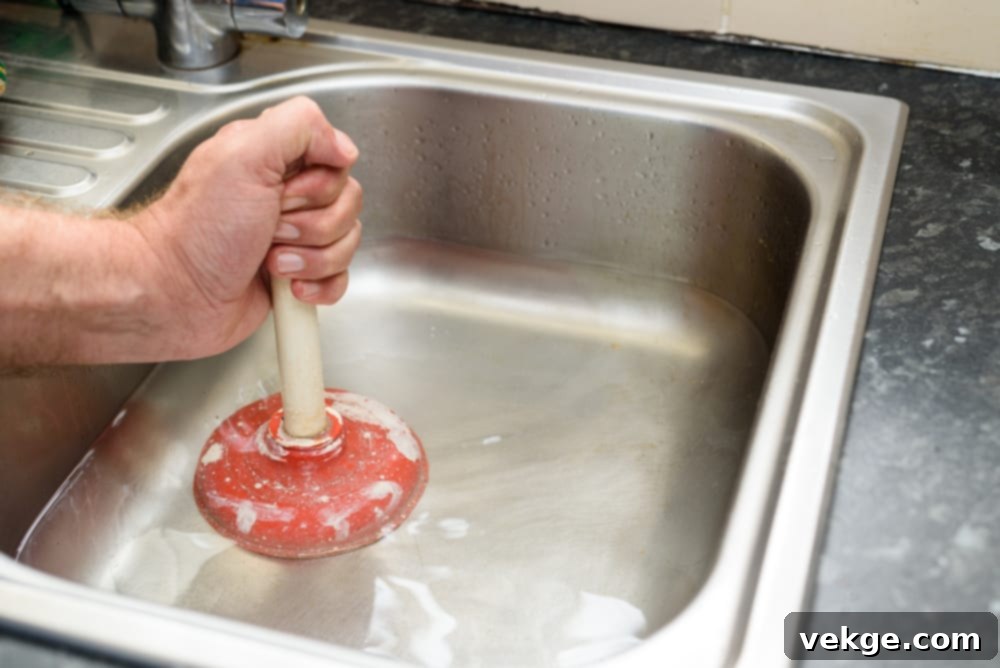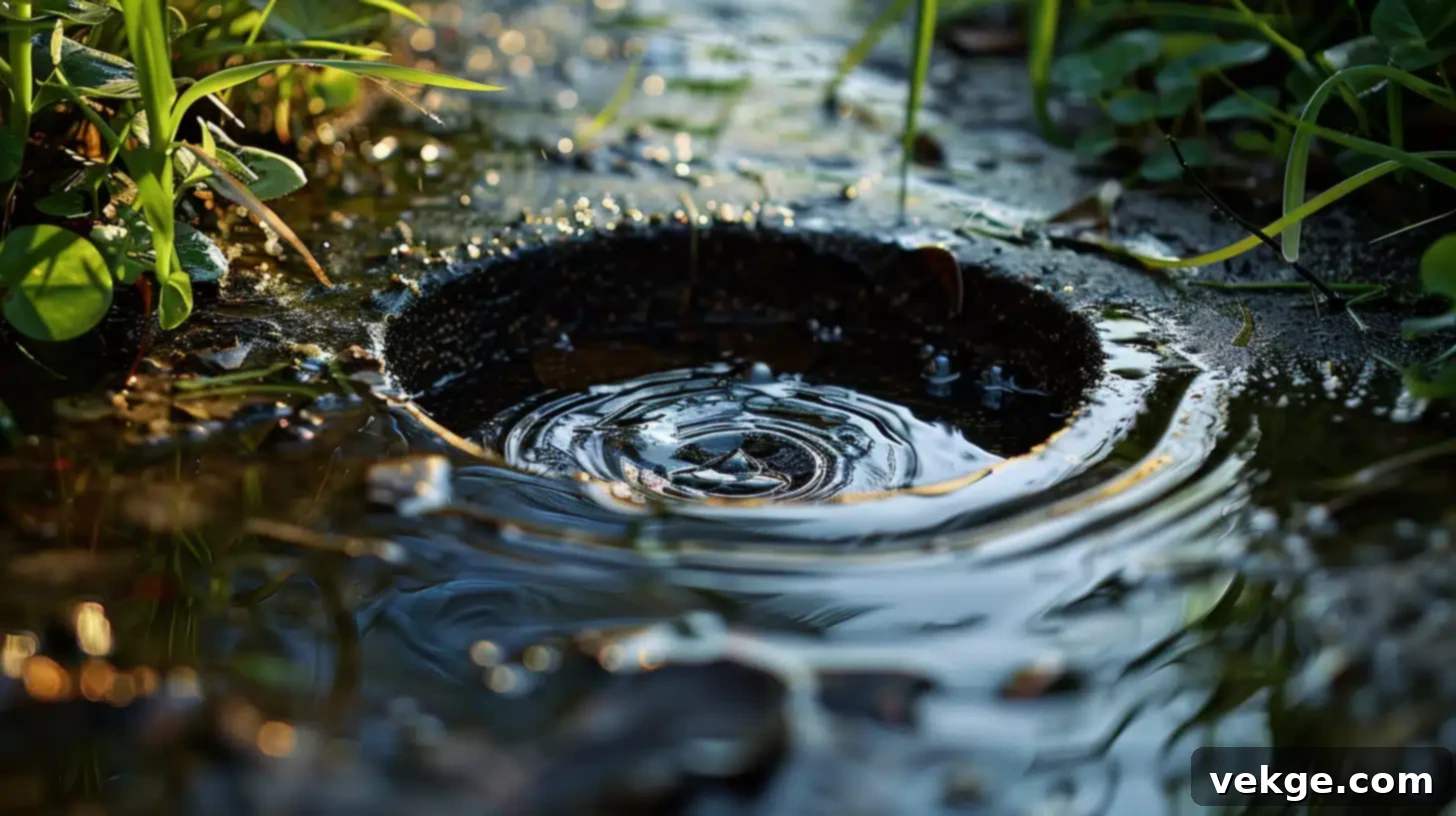Ultimate Guide to Identifying & Fixing Blocked Drains: Essential Signs & Solutions
We’ve all experienced the frustration – a kitchen sink that drains at a glacial pace, a shower floor slowly transforming into a miniature pond, or a toilet that struggles to flush. Blocked drains are more than just an everyday nuisance; they can disrupt your daily routine, lead to costly property damage, and even pose potential health risks if left unaddressed. While seemingly minor at first, these common household plumbing issues can quickly escalate into full-blown emergencies, causing significant stress and expense. But there’s good news: you don’t have to be caught off guard!
Understanding the early warning signs of a drainage problem is your most effective defense. By recognizing these indicators and taking prompt, appropriate action, you can often tackle blockages before they become severe. This proactive approach saves you time, money, and the headache of dealing with a major plumbing crisis. This comprehensive guide will walk you through the top signs of a blocked drain, explain the underlying causes, and provide practical advice on both quick-fix solutions and when it’s absolutely essential to call in the professionals to get your pipes flowing smoothly again.
1. Slow Draining Fixtures: The Primary Indicator of a Blockage

This is arguably the most common and often the first noticeable sign that something is amiss in your plumbing. When water takes an unusually long time to disappear down the drain, whether it’s in your kitchen sink, bathroom basin, or bathtub, it’s a clear indication that an obstruction is impeding its flow. In kitchen sinks, the primary culprits are usually accumulated grease, food particles, and soap scum that solidify and stick to pipe walls, gradually narrowing the passage. For bathroom drains, hair, soap residue, and even small forgotten objects are the typical offenders, forming stubborn clogs.
Similarly, a slow-draining toilet is a critical sign that demands attention. If your toilet seems to be struggling to flush properly, requiring multiple attempts, or if the water level rises precariously close to the rim before slowly receding, you likely have a partial or complete blockage. A sluggish toilet can indicate issues within the toilet trap, further down the waste pipe, or potentially a more significant problem in the main sewer line affecting your entire home. Addressing slow-draining fixtures promptly can prevent them from becoming completely blocked, which can lead to much messier and more difficult situations like overflows. If you’re in the London area and experiencing persistent slow drainage or other plumbing concerns, this team can provide expert assistance and drain cleaning services.
2. Unpleasant Odours: When Your Drains Smell Like Trouble
Beyond the visual cues, your nose can also be a powerful and early indicator of drainage problems. That unmistakable, foul, and often pungent smell emanating from your drains is not just an annoying aroma; it’s a critical warning sign that blockages are lurking below. These odours typically occur when decaying organic matter, such as food waste, grease, hair, and soap scum, gets trapped within your pipes and begins to decompose. As this material breaks down, it releases noxious gases, including hydrogen sulfide, which produces a distinctive rotten-egg smell. These gases can also be sewer gases backing up into your home due to a lack of proper ventilation in the blocked pipe.
Furthermore, stagnant water caused by blockages provides an ideal breeding ground for bacteria, mould, and mildew. If you notice a damp, earthy, or musty smell, especially around your drains or if you detect the presence of mould or mildew growth in adjacent areas, it strongly suggests moisture accumulation due to poor drainage. These odours are not only off-putting and detrimental to your indoor air quality but can also indicate potential health hazards if mold spores become airborne. It’s crucial not to simply mask these smells with air fresheners; investigate their source, as they point directly to a blockage that needs clearing to restore healthy living conditions.
3. Gurgling Sounds: The Pipes Are Trying to Tell You Something
If your drains have started serenading you with strange gurgling, bubbling, or sucking noises, especially after using another fixture in your home, it’s time to pay close attention. These peculiar sounds are not just random pipe noises; they are a clear acoustic signal that your drainage system is struggling. Gurgling typically occurs when air becomes trapped in the pipes due to a blockage. As water tries to push past the obstruction, it creates negative pressure, pulling air through the water in the trap. This disturbance in the water seal is what results in those distinctive gurgling sounds.
This phenomenon is particularly noticeable when you flush the toilet and hear gurgling from the shower drain, or when your kitchen sink gurgles as the washing machine drains its water. Such sounds indicate that the blockage is significant enough to affect the air pressure within the entire drainage system, potentially impacting multiple fixtures connected to the same line. While an occasional gurgle might not be a major concern, consistent or loud gurgling noises are a definite red flag. They suggest a substantial blockage that is impeding normal flow and ventilation, and they should prompt immediate investigation to prevent further complications like complete clogs or wastewater backups. Don’t ignore these audio cues; they are early warnings that your plumbing system needs attention.
4. Water Backing Up: A Clear Sign of a Plumbing Emergency

Nothing quite sends a shiver down your spine like seeing water backing up into your sink, shower, or even your toilet. This is a critical sign that indicates a complete or near-complete blockage, preventing wastewater from moving through the pipes as it should. When water can no longer flow past an obstruction, it has nowhere to go but back up the drain it just came from, or even into other connected fixtures that share the same waste line. This situation demands immediate attention and is often a sign of a significant problem.
For example, if you flush your toilet and water simultaneously bubbles up into your shower or bathtub, it’s a strong indicator of a blockage in your main sewer line or a significant branch line that affects multiple parts of your home’s plumbing. Similarly, if your dishwasher drains and water backs up into your kitchen sink, the shared drain is almost certainly clogged. Water backing up not only creates an unsanitary mess but also poses a significant risk of costly water damage to your property, including floors, cabinets, and walls. Furthermore, wastewater can contain harmful bacteria, viruses, and pathogens, making it a serious health hazard. This particular sign demands immediate professional attention, as delaying action can lead to extensive damage, unsanitary conditions, and significantly more expensive repairs.
5. Visible Signs of Blockage: Clues Beyond Your Indoor Pipes
Not all signs of a blocked drain are confined to your indoor plumbing fixtures. Sometimes, the problem manifests externally, offering visible clues to a deeper issue within your property’s drainage system. Overflowing gutters or downspouts, for instance, are often indicators of blockages in outdoor drainage systems, such as stormwater drains or underground pipes connected to your roof. Leaves, twigs, moss, and even bird nests can accumulate in gutters and downspouts, preventing rainwater from draining effectively. This overflow can lead to water pooling around your home’s foundation, potentially causing costly structural damage or basement flooding.
Another significant outdoor indicator is the presence of tree roots. Roots naturally seek out moisture and can aggressively invade underground sewer pipes, especially those with pre-existing cracks, loose joints, or weak spots. Once inside, they can grow and expand, forming dense, impenetrable blockages that trap debris and wastewater. Visible signs of tree roots invading your yard (like an area of unusually lush vegetation above a sewer line, or visible roots near pipe access points), or depressions/sinkholes in your lawn, could point to an underground pipe invasion. These types of blockages are notoriously stubborn, difficult to remove without specialized equipment, and almost always require professional intervention to clear and prevent recurrence, often involving trenchless repair methods or hydro-jetting to cut through the roots.
6. Recurring Clogs: A Deeper Problem Lurking Beneath the Surface

While an occasional clog might be easily remedied with a plunger or a simple DIY solution, a drain that repeatedly clogs in the same spot, or when multiple fixtures in your home are affected by persistent blockages, signals a more significant underlying issue. These recurring clogs are red flags that should not be ignored, as they often point to structural problems within your plumbing system rather than just a simple, isolated accumulation of debris. Relying solely on temporary fixes like chemical drain cleaners in such situations can even exacerbate the problem by damaging your pipes over time.
Possible culprits behind chronic, recurring blockages include:
- Partial Blockages: DIY methods might clear a small path for water to flow, but a larger, more resilient obstruction remains, quickly collecting new debris and leading to another clog.
- Pipe Damage: Cracked, corroded, collapsed, or misaligned pipes can create uneven surfaces or narrow sections where debris easily snags and accumulates. These structural issues require professional diagnosis and repair.
- Main Sewer Line Issues: If multiple drains throughout your home are consistently backing up or experiencing slow drainage, the problem likely lies in your main sewer line, which connects your home’s plumbing to the municipal sewer system. This can be due to severe tree root intrusion, significant grease buildup from years of accumulation, or structural damage to the main line itself.
- Improper Pipe Installation: Incorrect pipe slope, inadequate venting, or poorly installed pipes can lead to chronic drainage problems that no amount of plunging will resolve.
When faced with persistent blockages, it’s a clear signal that it’s time to call in professional plumbers. They have the tools and expertise to accurately diagnose the root cause and provide a lasting solution, preventing continuous inconvenience and potential long-term damage to your plumbing infrastructure.
DIY Solutions vs. Professional Plumbing Services: Knowing When to Call for Expert Help
Before jumping straight to professional services for every minor issue, it’s worth noting that several effective DIY solutions can often address simple, localized clogs. These immediate actions can save you time and money, and are excellent for preventative maintenance or minor blockages:
- Plunger Power: A good old-fashioned plunger is surprisingly effective for many sink, toilet, and shower clogs. Ensure a tight seal over the drain for maximum suction and plunge vigorously.
- Boiling Water (with Caution): For grease build-up in kitchen sinks, pouring hot (but not boiling if you have PVC pipes, as it can soften them) water slowly down the drain can help dissolve the grease. Follow with a flush of cold water.
- Baking Soda and Vinegar: This natural remedy can create a fizzing action that helps break down soft clogs. Pour half a cup of baking soda down the drain, followed by half a cup of white vinegar. Let it sit for 30 minutes to an hour, then flush thoroughly with hot water.
- Manual Drain Snake/Auger: For more stubborn hair or debris clogs that are within reach, a manual drain snake can physically break apart or pull out obstructions.
However, it’s crucial to understand when these DIY methods are insufficient or even harmful. Chemical drain cleaners, for instance, can be corrosive to pipes and harmful to the environment. If you experience recurring clogs, complete blockages (especially with water backing up), foul sewer odours that persist despite cleaning, or any signs of main sewer line issues, it’s a definitive sign that it’s time to stop DIY efforts and call in the pros.
When to Call Professional Plumbers for Blocked Drains
When all else fails, or if you’re dealing with persistent, severe, or suspicious blockages, don’t hesitate to call in the professionals. Professional plumbers have the expertise, experience, and specialized tools to accurately diagnose and effectively address even the most complex blockages. They offer advanced solutions that are simply not available to the average homeowner:
- Video Camera Inspections: Plumbers can use tiny, high-resolution cameras inserted into your pipes to precisely locate the blockage, identify its nature (e.g., roots, heavy grease, foreign objects), and assess the overall condition of your pipes without destructive digging. This is invaluable for accurate diagnosis.
- Hydro-Jetting: This powerful method uses high-pressure water streams (up to 4000 PSI) to blast away even the most stubborn blockages, including dense tree roots, heavy grease buildup, mineral deposits, and scale, thoroughly cleaning the entire interior circumference of the pipe walls.
- Industrial-Grade Mechanical Snaking/Augering: For extremely tough obstructions, professional plumbers utilize powerful augers that can cut through and remove blockages that household snakes simply cannot budge.
- Pipe Repair and Replacement: If the blockage is due to damaged pipes (cracks, collapses, corrosion), professionals can offer solutions ranging from trenchless pipe repair (which minimizes yard disruption) to full pipe replacement, ensuring a long-term fix.
Investing in professional drain cleaning and repair not only resolves the immediate problem but also helps prevent future blockages, extends the life of your entire plumbing system, and ensures the long-term health and safety of your home. Your drains – and your peace of mind – will definitely thank you for the expert care!
Ways You Can Book Professional Drainage Services
When a drain blockage strikes, particularly a severe one, urgency is often paramount. Prompt action can significantly minimize potential property damage, speed up the resolution process, and quickly restore your peace of mind. Thankfully, most reputable professional drainage companies understand this need for rapid response and offer a variety of convenient ways to contact them and book their services. This flexibility allows you to choose the booking method that best suits your comfort level, the urgency of your situation, and your lifestyle. Let’s explore the common ways you can reach out and get expert help for your drainage problems.
1. Over the Phone: For Immediate Needs & Direct Communication
For many homeowners, the most direct and often preferred method for booking drainage services is a simple phone call. Most professional drainage companies provide a dedicated telephone number, allowing you to speak directly with a knowledgeable team member. This immediate interaction offers several distinct advantages, especially when dealing with urgent situations:
- Instant Communication: You can explain your issue in detail, describe the symptoms you’re experiencing, and get immediate feedback or initial advice from a professional.
- Emergency Services: For urgent or emergency blockages (like overflowing toilets or severe water backup), a phone call is almost always the fastest way to dispatch a technician to your location, often within hours. Many companies offer dedicated 24/7 emergency lines.
- Real-time Information: You can inquire about service availability, estimated arrival times, and often get an initial quote or cost estimate for common services directly over the phone.
- Ask Questions: This direct line of communication allows you to ask as many specific questions as you need about their diagnostic strategies, the likely duration of the job, specific tools they use, and their pricing structure before committing to an appointment.
Before making a phone call, it’s wise to have details about your specific drainage issue ready (e.g., which fixture is affected, how long it’s been happening). Also, be sure to check the company’s standard operating hours for phone support, especially if your issue isn’t an emergency, as not all services offer round-the-clock booking via phone for non-urgent matters.
2. Online Appointment Booking: Convenience at Your Fingertips
In our increasingly digital world, many people prefer the convenience and flexibility of online booking, particularly those who dislike making phone calls or whose busy schedules make it difficult to call during traditional business hours. Recognizing this growing preference, most modern drainage services now offer user-friendly online appointment systems directly via their websites. This method is typically quick, simple, and can often be completed in just a few minutes, making it highly efficient.
- 24/7 Accessibility: You can book an appointment anytime, day or night, from the comfort of your home or while on the go using a smartphone or computer. This is ideal for planning ahead.
- Streamlined Process: Online forms are often designed to guide you through providing all essential information about your drainage problem (type of issue, location, preferred date/time), ensuring all necessary details are captured accurately.
- Digital Confirmation & Reminders: You’ll usually receive instant email confirmation of your booking, often with details about what to expect, a reference number, and sometimes even automated reminders closer to your appointment time.
- Reduced Waiting Time: While not immediate for emergencies that require instant dispatch, online systems often process requests efficiently. You’ll typically receive a follow-up call or email within a specified timeframe to finalize details or confirm the booking.
Before using an online system, quickly read through the company’s online booking process or FAQs. Some companies might provide a clear timescale for when they will get back to you, allowing you to plan accordingly and manage expectations.
3. By Email: For Non-Urgent Queries & Detailed Documentation
While less immediate than a phone call or online booking, contacting a drainage company by email can be a suitable option for non-urgent drainage issues, general inquiries, or when you need to provide a very detailed account of your problem. This method provides a written record of your communication, which can be beneficial for documentation purposes and for clarity.
- Detailed Description: Email allows you to provide a comprehensive, detailed description of your problem, attach photos or even short videos if helpful, and articulate all your questions without feeling rushed or forgetting important details during a conversation.
- Documentation & Record-Keeping: You have a written record of your request, the company’s response, and any agreed-upon details, which can be immensely useful for future reference, warranty claims, or if you need to compare services.
- Suitable for Non-Emergencies: This method is best reserved for issues that aren’t causing immediate damage, severe inconvenience, or posing a health risk, as response times can vary from a few hours to a business day or more, depending on the company’s policy and workload.
If you suspect a significant blockage, a potential main sewer line issue, or an emergency situation, **exercise extreme caution with this method.** Waiting days for an email response when dealing with a major plumbing issue can exacerbate the problem, lead to more serious consequences, and significantly increase repair costs. Always prioritize phone calls or emergency online booking for critical concerns; use email for less critical questions or as a preliminary contact before a follow-up phone call for official booking.
Conclusion: Stay Vigilant, Act Promptly, and Protect Your Home’s Plumbing
Blocked drains may be a common and frustrating aspect of homeownership, but they don’t have to become major headaches or lead to costly catastrophes. By staying vigilant and understanding the key warning signs – from slow draining fixtures and foul odours to strange gurgling sounds and alarming water backing up – you can catch these issues early. Remember that recurring clogs, visible signs of outdoor pipe problems, or any indication of main sewer line trouble often signal a deeper, more complex issue that absolutely requires professional attention.
Don’t underestimate the power of proactive maintenance and early intervention. While simple DIY solutions can effectively address minor, localized clogs, knowing when to stop your own efforts and call in professional plumbing services is crucial for preventing escalating damage, ensuring the longevity of your home’s drainage system, and protecting your property and health. Whether you choose to book by phone for immediate help, online for convenience, or via email for detailed non-urgent queries, taking prompt action is always the best strategy. Keep your drains clear, your home protected, and enjoy the peace of mind that comes with a smoothly flowing, healthy plumbing system!
